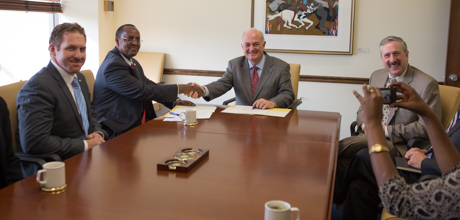George Washington University President Steven Knapp and Idle O. Farah, director-general of the National Museums of Kenya, signed a letter of intent on Tuesday to begin collaborations to operate the Koobi Fora Field School, one of the world’s premier international paleoanthropology training operations.
With the signing, the National Museums of Kenya and GW’s Center for the Advanced Study of Hominind Paleobiology are making the first steps toward providing a unique research opportunity for George Washington students and faculty to explore Africa and to search for evidence of hominins—human ancestors— in one of the most dramatic landscapes in the world.
“This new relationship with the National Museums of Kenya represents a groundbreaking opportunity for our students, the Anthropology Department and GW as a whole,” said Assistant Professor of Anthropology David Braun, lead George Washington representative for the partnership.
University administrators and faculty in attendance for the signing included Provost Steven Lerman; Columbian College of Arts and Sciences Dean Peg Barratt; Associate Provost of International Programs Donna Scarboro; Department of Anthropology Chair Brian Richmond; University Professor of Human Origins Bernard Wood, director of the Hominid Paleobiology Doctoral Program; and Dr. Braun, co-director of GW’s Center for the Advanced Study of Hominid Paleobiology.
Located in Kenya, the Koobi Fora Field School is designed to introduce students to the science of paleoanthropology, a sub-discipline of anthropology focused on the study of human origins.
Some of the research projects George Washington University students could participate in include studying fossilized footprints from 1.6 million years ago, finding evidence of human scavenging and hunting two million years ago, exploring evidence of climate change and animal communities over the last four million years and discovering the changes associated with the appearance of domesticated animals in East Africa.
Other collaborators on this project include faculty members from the University of Witwatersrand, University of Cape Town, Max Planck Institute for Evolutionary Anthropology, Rutgers University, Coastal Carolina University and the Smithsonian Institution.
“Paleoanthropology science is a less well understood subject in most African institutions and the opportunity for local students to attend the Koobi Fora Field School program through the partnership will raise the bar of excellence in this field of study for these students,” said Purity Kiura, archaeology division head of the National Museums of Kenya and lead representative of the Koobi Fora Field School. “In addition, the interaction of these local students with their international peers will broaden and enhance their working relationships.”


